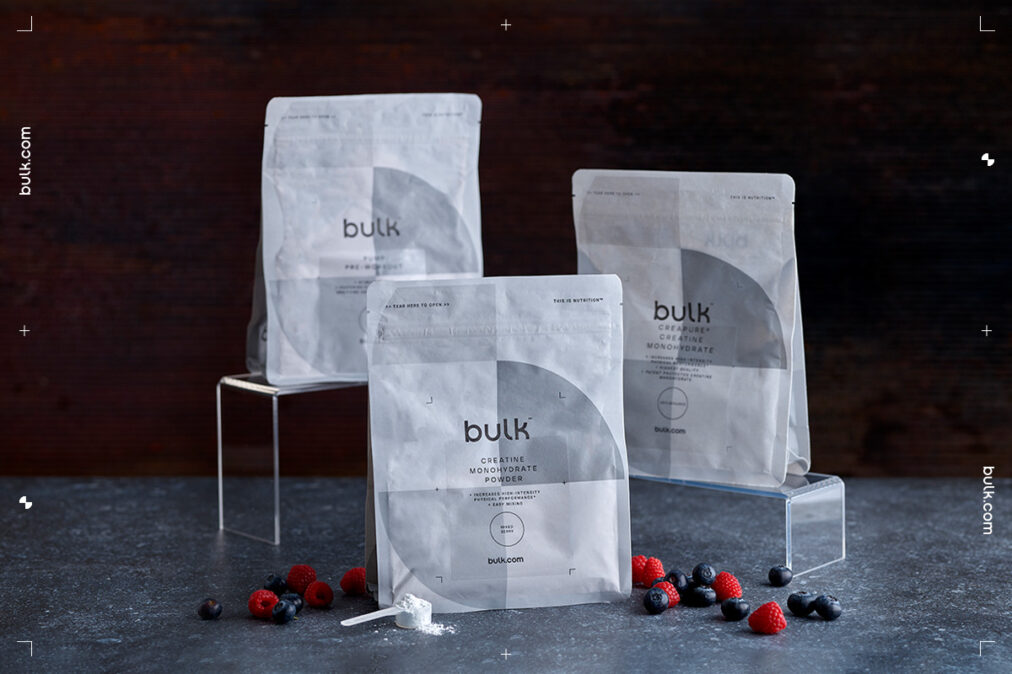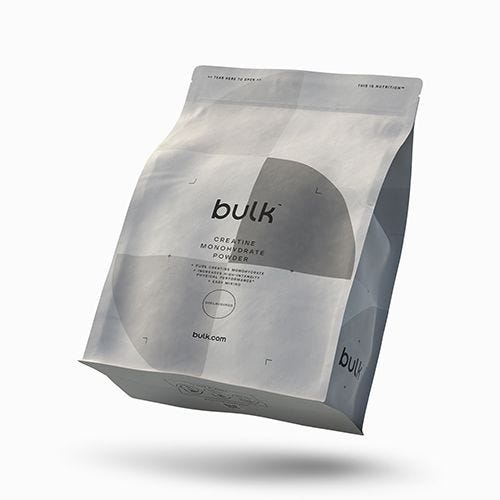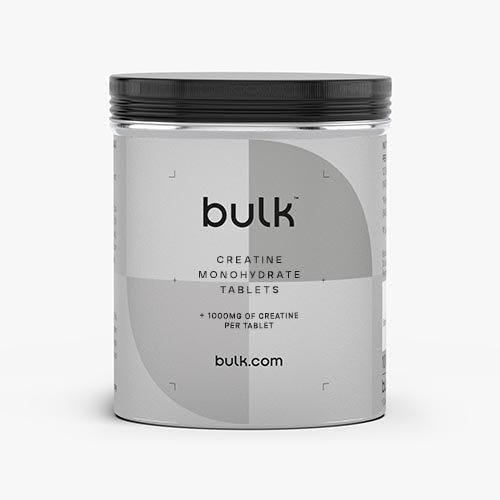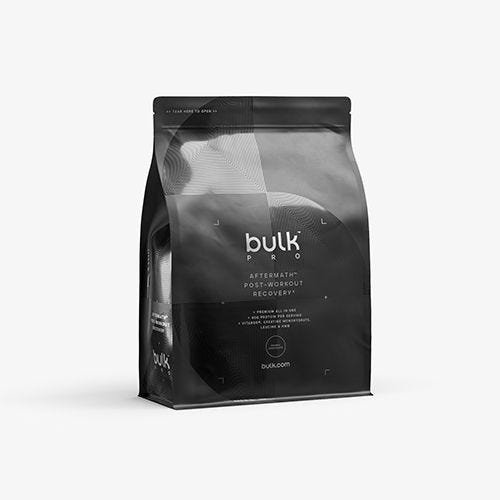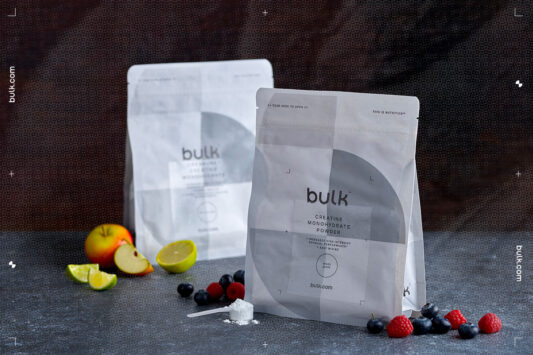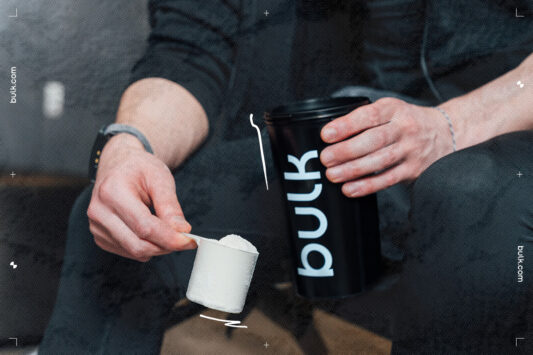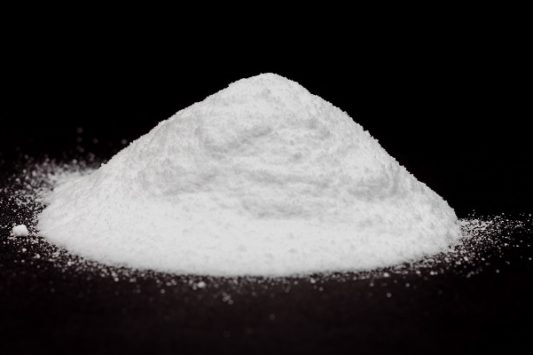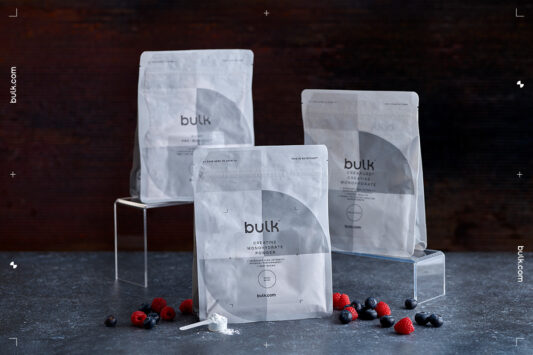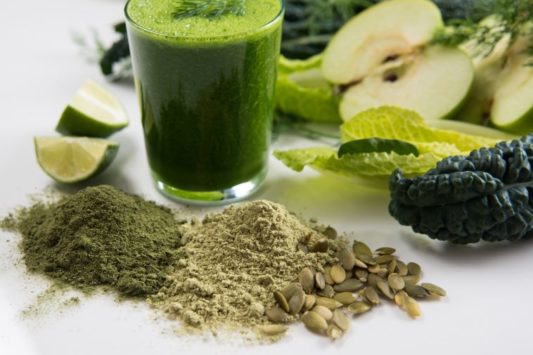Creatine is one of the most trusted and widely researched supplements in the world. Taken by bodybuilders, athletes and powerlifters alike, its status as one of the most popular supplements is undisputed. Despite its popularity, many people in the industry are still unaware of how to take creatine. With some insights from Simon Jurkiw, Product Director at Bulk™ and an expert with twenty years’ experience in fitness, we’ll be diving into what creatine is, what it does and how to take it.
What is creatine and what does it do?
Creatine is a nitrogenous organic acid made out of three amino acids: L-arginine, glycine and L-methionine. Its main purpose is to provide immediate energy for the muscles (we’ll explain what we mean by this later).
Creatine is beneficial for athletes, sportspeople and bodybuilders [1], primarily because it increases their ability to produce energy.
The average 70kg person stores around 100-120g in their skeletal muscle, but has the capacity to store 160g. Creatine supplementation aims to fill up this tank, allowing the muscles to have a constant supply when needed for ATP re-synthesis.
As well as being produced naturally in the liver, we get creatine from protein-rich foods like meat and fish. But to reap the performance-enhancing benefits, supplementation is beneficial to maximise creatine stores in the muscles.
In a normal diet that contains 1–2 g creatine per day, muscle creatine stores are about 60–80% saturated. Therefore, supplementation of creatine serves to increase muscle creatine by 20–40% [2].
“There’s so many misconceptions about what creatine actually is”, says Simon. “Creatine is found in everyone’s muscles, and put simply, it’s an organic compound used for high intensity energy.”
Related Products
How does creatine work?
For us to fully understand how creatine works, we first need to understand how our body produces energy.
The body has three energy systems:
- The glycolytic or anaerobic pathway (bursts of prolonged intense movement, like a 400-metre sprint).
- The oxidative or aerobic pathway (slower, steadier energy output, like a 10k run).
- The phosphagen or ATP-CP pathway (explosive, immediate energy, like jumping or punching). Some sports, such as rugby or football, use a mixture of these energy systems.
Adenosine triphosphate (ATP) is a molecule that carries energy within cells. It’s the body’s immediate source of energy and is needed for explosive, immediate movements such as sprinting short distances (up to 100m), throwing a punch and the first few repetitions on a bench press.
Now for the technical bit. When cells use ATP for energy, ATP converts into adenosine diphosphate (ADP), causing a big release in energy. Creatine sits in our muscles in the form of creatine phosphate (or phosphocreatine). Creatine’s job is to donate a phosphate group to ADP, allowing it to be converted back into ATP. The cycle continues, and ATP continues to drop a phosphate group, creating energy and becoming ADP. The more creatine stores you have, the longer this process can continue.
So, in summary, creatine supplementation increases the stores of cellular phosphocreatine, which can accelerate the recycling of ADP into ATP, making more energy available for high-intensity exercise.
In simple terms: more creatine stores = more rapid energy. By supplementing with creatine, you are maximising your high-intensity energy output.
How to use creatine
Creatine can be used by gym-goers and sports people. For gym-goers, this increase in energy can lead to greater training adaptations. That’s because the body can perform more repetitions at heavier weights, creating a greater stimulus for growth. The benefit of creatine supplementation is all about greater output during training sessions and athletic performance.
“The number one reason you should use creatine is to improve performance. Be that gym performance or sporting performance”, says Simon.
“In the gym, creatine will help you to do more reps and it’ll help you to lift more weight. Ultimately, creating a greater stimulus for muscle growth. There’s a reason it’s so popular. On the sporting side of things, creatine is responsible for high intensity energy, such as sprints. Take a game like football, where players tend to sprint every 15-30 seconds. That fuel is coming from creatine.”
How much creatine should you take?
The creatine loading phase involves taking approximately 20g of creatine per day (four servings of 5g) for five to seven days. The primary objective of the loading phase is to increase muscle creatine levels quickly.
After this week is complete, bring your creatine intake right down. The scientific literature suggests that smaller, daily doses of creatine supplementation are the most effective. Specifically, this equates to 3-5g.
When to take creatine
There’s no specific time for when to take creatine. Your body will store it inside your skeletal system until it’s needed. So the best time to take creatine depends on you and when it’s most convenient.
Many people like to mix creatine into their pre-workout or post-workout drinks. Others stir it into breakfast porridge. Unflavoured is tasteless and mixes well, so it’s easy to include it in all sorts of shakes and smoothies. Consistency is all that matters. Whether you take it in the morning or the afternoon, the important thing is to take it every day.
What is creatine cycling?
It’s popular to take creatine in a 12-week cycle, in which you supplement for eight weeks, take two weeks off and then continue. This is called creatine cycling.
There are typically two phases to creatine supplementation: loading and maintenance. During the maintenance phase, 3-5g per day is most effective. Mixing creatine with a carb source like dextrose can also help with muscle creatine saturation because the insulin transports nutrients to the muscles faster.
After a one-week loading phase, cut back on your daily intake to 3-5g. Continue doing this for another seven weeks, maintaining a steady, consistent intake. After eight weeks, it’s time to pause your creatine supplementation for 14 days before resuming.
Why should you cycle creatine?
Our bodies are good at regulating things. If you take a substance that your body produces naturally, it can sense the increase and therefore turn off natural production. If prolonged supplementation can impair natural production, having planned time off the substance allows our body’s natural production to return to normal.
Should you take creatine before or after a workout?
You can take creatine before or after a workout. As long as you’re consuming 3-5g per day, it doesn’t matter when you take it. The best time to take creatine is the time most convenient for you, allowing you to be consistent.
What are the different types creatine?
Several different types of creatine exist, but creatine monohydrate is by far the most popular.
The main difference between the supplements is how the creatine molecules bond, which impacts how we metabolise them and break down in the body. If you’re thinking about using creatine for the first time, creatine monohydrate is recommended.
“One area that’s talked about a lot in gyms are the different forms of creatine,” says Simon. “In reality, there’s one form that all of the research is on – that’s creatine monohydrate. You don’t need to pay double or triple the amount for fancy different forms of creatine when creatine monohydrate will do the job well.”
Creatine Monohydrate Powder
This is by far our most popular creatine product, and for good reason. The Unflavoured version contains 5g creatine monohydrate per scoop. Its mild taste means it can be mixed with other powdered supplements, such as protein shakes. It’s perfectly fine to combine creatine with whey protein or vegan protein powder. It won’t affect absorption.
Creatine Monohydrate Tablets
Creatine tablets are great for people who don’t drink shakes. Each tablet contains 1g creatine, meaning you’d need to take 3-5 per day in the maintenance phase.
Frequently Asked Questions
Why should I use creatine?
We have access to extensive research on creatine benefits for increasing strength, gaining muscle and high-intensity training is unequivocal. The Journal of the International Society of Sports Nutrition (Buford et al, 2007) said, in its position paper on creatine [3], that, “Creatine monohydrate is the most effective ergogenic nutritional supplement currently available to athletes in terms of increasing lean body mass during training.”
What is the best creatine dosage?
3-5g per day. After evidence-based scientific literature suggests that smaller, daily doses of creatine supplementation are the most effective. This is how to take creatine and get the best results.
How often should you take creatine?
When on a cycle, you should take creatine every day. This is 3-5g if you’re in a maintenance phase and up to 20g in the creatine loading phase.
How long does creatine take to kick in?
It can take anywhere from two to four weeks to see the effects of creatine on your energy levels. Be consistent in taking it daily, even if you don’t see effects after a few weeks. Trust in science.
Should I take creatine on rest days?
Yes. During a creatine cycle, you should take creatine every day. Rest days included.
What happens if I take creatine and don’t work out?
To get the benefits from creatine supplementation, you need to do the work in the gym.
Taking creatine without working out won’t lead to anything without muscle stimulation. That said, some studies suggest it has a critical role in brain bioenergetics [4].
Summary: How to take creatine
“In summary, creatine is a naturally occurring compound, and everyone has creatine stored in their muscles”, says Simon. “The aim of supplementation is to fill up the creatine fuel tank so we can perform more high intensity exercise or more gym-based activity. It’s inexpensive. It’s convenient and it’s a safe and effective supplement.”
Related articles
Looking to learn more when it comes to creatine and sports nutrition? We believe that every person, with support, has the right to transform their lives through fitness. That’s why we’ve put together articles with expert advice, all to help you on your fitness journey. Check out more articles below.
Building muscle mass Creatine vs whey
Creatine loading Creatine ethyl ester
Safe supplements Scientifically proven supplements
Types of creatine Best intra workout
Creatine pre workout Best supplements for muscle growth
